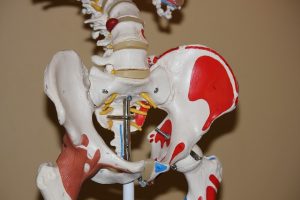Sacroiliac Joint Pain – What Is It? What Causes It?
An Overview of Sacroiliac Joint Pain: What is it? What causes it? How is it treated?
What is the Sacroiliac Joint?
 The sacroiliac joint (also known as the SI joint) is the joint between the sacrum bone and the ilium bone.
The sacroiliac joint (also known as the SI joint) is the joint between the sacrum bone and the ilium bone.
Sacrum – From the anatomy of the spine we know that the sacrum is the lower bone in the spine, formed when the sacral vertebrae fuse in young adulthood.
Ilium – We each have two ilium bones. These are the large portions of our hip bones, shaped almost like an ear or a wing.
Sacroiliac joints (we each have two) are the joints where the bottom of the spine (the sacrum) meet the ilium bones on each side. The spine and pelvis are held together by the ligaments of this joint. In this manner the pelvis helps to support the spine, which is supporting the weight of the upper body.
Sacroiliac Joint Dysfunction, Sacroiliitis and SI Joint Pain
Though the terms sacroiliac joint dysfunction, sacroiliitis and SI joint pain may be used interchangeably they are not the same. Here’s what each term means:
Sacroiliac Joint Dysfunction is irregular movement of the SI joint. Most of the time SI joint dysfunction involves too much or too little movement of the joint.
Sacroiliitis is inflammation of the SI joint, typically caused by SI joint dysfunction.
SI Joint Pain is pain from the SI joint region, typically caused by inflammation of the joint (sacroiliitis).
In general, this is what is going on when someone experiences SI joint pain:
Sacroiliac Joint Dysfunction → Sacroiliitis → SI Joint Pain
What Causes Sacroiliac Joint Pain?
So now we know that SI joint pain is caused by inflammation of the joint which was original caused by irregular movement of the joint. But what causes that? Why is the joint moving irregularly? Here are some reasons why an individual may have SI joint dysfunction.
- An injury such as a car accident or other sudden impact can cause the ligaments of the SI joint to be stretched, torn or sprained. Damaged ligaments can then allow for excess motion of the joint and cause the joint to move irregularly.
- During pregnancy and childbirth women produce a hormone, relaxin, which allows for the ligaments to relax. After an especially long childbirth or bearing a large baby a woman’s ligaments may not retract fully to their original tautness. This can result in excess mobility of the SI joint.
- As people age they are more susceptible to degenerative joint disease or arthritis. These can both lead to irregular motion and dysfunction of the joint.
- Various anatomical traits may predispose a person to having SI joint dysfunction. For example, an abnormal gait, having one leg longer than the other, having a disorder such as scoliosis or having an injury which causes an abnormal gait will all increase the chances of the individual developing SI joint dysfunction.
What are Symptoms of SI Joint Pain?
SI joint pain starts at the SI joint but can also be felt in the buttocks, groin, thigh or middle back.
Pain caused by SI joint dysfunction is often on one side of the body (though it is possible to have bilateral SI joint pain).
Individuals with SI joint pain may notice that their pain is worse when standing up from a seated position or is worse in the morning.
What are the Treatments for SI Joint Pain?
In the beginning typical treatment methods to relieve SI joint pain are rest, physical therapy, ice and/or heat therapy and anti-inflammatory medication.
If initial treatment methods aren’t successful or pain continues for several weeks, your doctor may recommend an SI joint injection. An SI joint injection is a simple procedure in which an injection of anti-inflammatory and/or anesthetic eases the inflammation and pain.
In severe cases, your doctor may recommend surgery to correct the SI joint dysfunction or stabilize the the joint to prevent pain.
References
